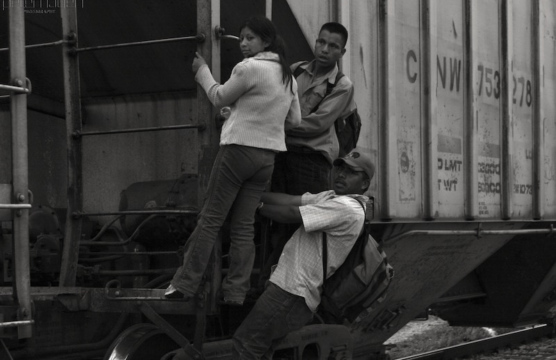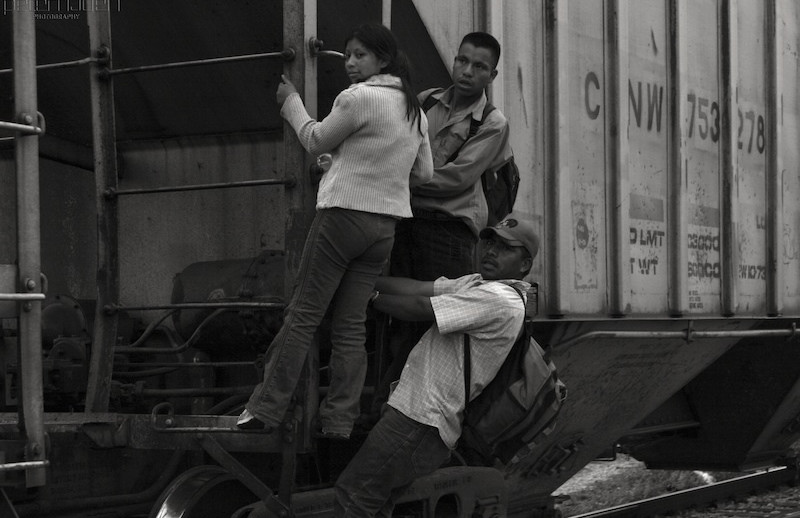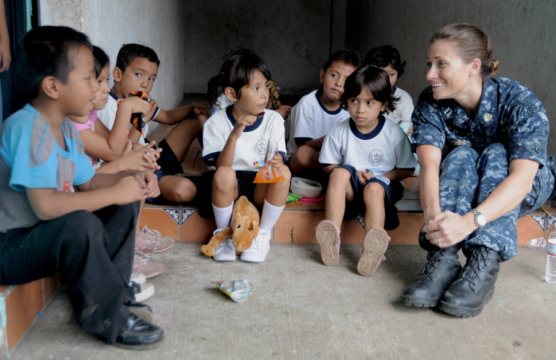
Migration & Development: Trends & Policy Options
Despite the economic importance of migration, Central American governments have lacked integral policies to leverage migration for development.
Chairman Carper, Ranking Member Coburn, and members of the Committee on Homeland Security and Government Affairs, I very much appreciate the opportunity to appear before you today to share my views about the root causes that are motivating Central Americans – especially unaccompanied children and families – to leave their home countries and try to enter the United States. I commend the Committee for focusing on these causes and identifying the most effective ways to mitigate them.
In light of heightened media attention in recent days, there is now a widespread consensus about an emergency and humanitarian crisis on our southern border. More than 52,000 Central American children, passing through Mexico, have sought entry into the United States. Despite the broad agreement on the need to tackle the challenge, however, a fierce political debate in the United States has ensued.
While a variety of proposals have been put forward to deal with the tragic and urgent situation, most of these are little more than stop-gap measures that seek to provide humane treatment to the children and either hasten or slow deportations of the minors. The bulk of President Obama’s $3.7 billion request to Congress, though targeted to essential purposes that mostly deal with current conditions on the US side of the border, is nonetheless unlikely to stem yet another wave of migrants coming from Honduras, Guatemala, and El Salvador down the road.
It is essential to step back and examine carefully what accounts for this tremendous influx of migrant children from our closest neighbors. Only in this way will it be possible to devise longer-term strategies that have a chance of succeeding by promoting more viable societies. The underlying causes of the complex phenomenon are many. The approach must therefore be balanced and comprehensive, encompassing several different dimensions at once.
Further, however tempting it may be, it is futile to point fingers and blame either the United States or the Central American governments and societies for contributing to the crisis. There is more than enough responsibility to go around. No one should be let off the hook. The only ones who don’t deserve blame are the children themselves, who are only seeking a better life. Fundamental changes both in particular in these three countries that make up the so-called Northern Triangle, as well as in US government policies and efforts pursued by international organizations and the private sector, will be required to produce a sustainable solution to the crisis. The current approach is obviously inadequate and not working.
The chief cause of the surge in out-migration from the three countries is a severe crisis of governance. For a substantial share of the populations in Honduras, Guatemala and El Salvador conditions are dire. These countries are not only economically troubled and facing a difficult external environment, but are also beset by among the world’s highest homicide rates and other forms of violence and abuse. The capacity of the government to provide protection for its citizens – indeed, to deliver basic services -- is extremely limited. Institutions, both public sector and private, are notably fragile. Corruption is pervasive and shows few signs of abating.
These problems did not appear overnight. They are longstanding, and were exacerbated by the civil conflicts of the 1980s, where Central America was a primary battleground of the Cold War. Though the ideological battle happily receded, the institutional precariousness persisted and, if anything, worsened. It is often asserted that more people today fall victim to criminal violence in countries like El Salvador than were killed during the height of that nation’s politically motivated war.
In recent years, the Northern Triangle countries in particular – though distinct in many key respects -- have witnessed further institutional decay and economic distress. With accelerating urbanization, many young people from these three societies have moved to the cities, only to find few opportunities for stable employment and spreading criminality. It is not surprising that violent youth gangs known as maras (especially in El Salvador and Honduras), as well as organized crime, have flourished in an environment where governance structures are weak, corruption is rampant, and illicit activities have been most profitable.
The drug trade is a key dimension of the problem. These Central American nations are strategically located between the coca-producing South American countries and the United States, the major market for cocaine. Serious efforts to deal with the problem in Colombia, to the south, and Mexico, to the north, have tended to only make conditions worse in Central America. Although the insecurity certainly cannot be reduced to the drug question, it is a critical piece of the overall puzzle and needs to be addressed. Reliable studies show that a substantial share of the violence is either directly or indirectly linked to drugs – in these cases, cocaine.
Another significant cause of the recent upsurge of migration of unaccompanied minors from the region is the strengthening of a particular criminal group – so-called coyotes. The coyotes profit from human trafficking and smuggling across the border into the United States. Some astute observers attribute the current crisis less to any change in US laws or even to the actual conditions of insecurity – which have long been quite acute – and more to the increasing grip of this particular criminal group.
While there have been important and useful efforts to deal with these serious challenges and root causes of the migration of minors from the Northern Triangle countries, these have clearly fallen short and need to be carefully reconsidered. The current crisis provides an opportunity to do so.
To date, the most noteworthy program of the US government has been CARSI, the Central America Regional Security Initiative, which has supported three main activities: narcotics interdiction and law enforcement, institutional capacity building, and violence prevention. The largest share of US security aid is directed toward narcotics interdiction and law enforcement, and emphasizes providing technical support, equipment and training to enhance antinarcotics operations. The Obama administration has requested an additional $130 million for CARSI in FY 2015; since 2008, over $800 million has been pledged for this initiative.
CARSI and other US government efforts in Central America have been worthwhile but have failed to address the root causes that are driving the humanitarian crisis on our border. The overarching focus of US collaboration in the coming years should be on strengthening institutions, in particular the police and court system, to enhance the rule of law. This is the core of these countries’ governance problems, and need to be the main emphasis of US support. Given the magnitude of the problem and what is at stake, resources should be considerably increased, beyond what President Obama is now proposing for this purpose.
Currently assigned funds should be reallocated. Washington’s emphasis on the interdiction of drugs passing through Central America has had little impact on the quantity or price of narcotics in the United States. Many experts believe it may be fueling the spreading criminality. Bolstering state capacity and governance is necessary to reduce the drug problem that is contributing to the region’s violence. To be sure, this is not an easy task. It will doubtless take many years and depends on reliable partners, but is essential to undertake.
In fact, it is crucial for the US to reassess its anti-drug policies overall. To its credit, the United States has recently stepped up efforts to curtail demand for illicit drugs. A number of programs are showing promising results. But a successful campaign to cut demand will require a far more significant policy shift from law enforcement to initiatives focused on prevention and treatment.
Within Honduras, Guatemala and El Salvador, the US government, international organizations and private, church groups should provide substantially more support to community-based youth programs which, if well implemented, can help keep children in their home countries. These programs should not only be for repatriated returned migrants, but should be targeted to those who are most likely to leave. It is essential that, through effective training, such programs offer greater economic opportunities for at-risk youth and help strengthen the social fabric.
High priority should also be given to efforts to reduce poverty in these countries. While there is no exact correlation between levels of insecurity and development, there is little doubt that economic desperation is one of the main root causes of the outflows from the region. A number of measures, by no means exhaustive, can and should be taken:
First, since these countries are so heavily dependent on remittance flows from family members, mainly in the United States, efforts that seek to build assets through savings among recipients should be increased. (Recent US measures to prevent money laundering are raising the cost of family remittances to Central America. The money amounts to $15 billion a year, roughly 10 percent of the region’s gross domestic product. The new measures could deprive the region, and its poorest families, of more than $1billion a year.)
Second, programs focused on small-business development, and that emphasize skills training, entrepreneurialism, and higher productivity should be considerably expanded in these countries. This would mean a shift in the current development strategy being pursued in much of the region and would require ample resources and a long-term, gradual approach.
Finally, Washington should take into careful account the impact of trade and other economic policies on Central America. Throughout the region, for example, there is concern about current US negotiations towards the Trans-Pacific Partnership. Lower-cost clothes produced in some Asian nations that are part of the negotiations could negatively affect the strength of Central America’s textile industries and the wider economy.
Indeed, looking ahead, Central America – and especially the Northern Triangle nations – can no longer be an afterthought and only a matter of serious attention when a crisis emerges. A commitment to address the principal factors behind today’s urgent situation on the border will require sustained support and follow through.
More productive cooperation between the US and Central American governments and societies is not only possible but essential. Apart from the proposed measures to deal more effectively with processing young migrants on the US side, it is crucial to improve communication and coordination between US officials and local authorities in Central America about convicted felons from the region who are returned as deportees. This would help officials take appropriate measures to deal with the dangers criminals may pose. Timely information needs to be shared to avoid aggravating already intolerable levels of violence.
Another possible area for increased collaborative efforts should be on targeting the coyotes, whose expanding and more sophisticated criminal activities are clearly contributing to the current crisis. US officials should work closely with Central American authorities to attempt to disrupt and reduce the profitability of these groups that are engaged in human trafficking and smuggling across the border.
There is ample evidence that, for many of the minors who are coming to the United States, there is a real risk of violence and abuse if they are forced to return to their home country. As a result there is a strong case to be made that, when circumstances warrant, the US should regard such victims as refugees and consider granting asylum. The argument made by the UN Refugee Committee has a great deal of merit: Because the home country cannot protect individual basic rights, the international community is obligated to step in; in this case, the U.S. must seriously evaluate the merit of unaccompanied minors’ asylum requests, as protection from systemic violence cannot be guaranteed from neither their families nor the government.
While recent changes in US laws are not the most significant determinants of the recent surge in young migrants from Central America, the border crisis could have been averted if the US had comprehensive immigration reform. It is clear that the current system is broken and requires a major overhaul. If a significant share of the estimated 11 million unauthorized immigrants in the US had legal status, for example, they would be able to travel between the United States and their home country and the prospect of waves of children coming to be reunited with their parents would be reduced.
One key lesson we should learn from the US’s successful engagement with Colombia over the past 14 years is that bipartisan support is absolutely fundamental. In the same way, it is important to reach broad agreement in the US Congress on a sustained, rational effort to help support our closest neighbors that find themselves in dire straits. While increased resources are critical, effective assistance in implementing institutional changes is also required to alleviate poverty and reduce criminality.
The main focus of our involvement in the Northern Triangle nations –as it was in Colombia – should be on helping to enable the government to assert its authority and protect its citizens from violence. Until the situations become more stable and under control, the risks of remaining in these countries will outweigh the risks of trying to reach the US border. The proposal under consideration, though valuable and needed in many respects, is not enough. There is no quick fix, any effort will take a long time, but the increasingly ominous conditions require a swift, constructive, and bold response.
Despite the economic importance of migration, Central American governments have lacked integral policies to leverage migration for development.
What is behind the spike in unaccompanied children crossing the border?
The United States must not only reform its domestic immigration policy, but also reassess its drug, trade, and foreign-aid policies toward the region.
 Peter Haden / CC BY 2.0
Peter Haden / CC BY 2.0

